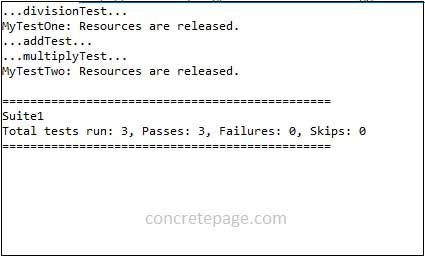TestNG @AfterClass Annotation
March 23, 2023
In TestNG test class, we can have a method that will run before test class destruction. To create such method, we need to use @AfterClass annotation. The @AfterClass annotated method will run after all the test methods in the current class have been run.
Find the code snippet to use
@AfterClass annotation.
public class MyTestOne {
------
@AfterClass
public void destroy() {
System.out.println("Resources are released.");
}
}
@AfterClass method can be used to release the resources used by test methods, close database connections etc.
Using @AfterClass
Example-1: In this example, we have a test class containing a method annotated with@AfterClass and a method annotated with @Test. In the output we will see that @AfterClass method is running after @Test method.
MyTestOne.java
package com.concretepage;
import static org.testng.Assert.assertEquals;
import org.testng.annotations.AfterClass;
import org.testng.annotations.Test;
public class MyTestOne {
@Test
public void divisionTest() {
System.out.println("...divisionTest...");
assertEquals(30 / 5, 6);
}
@AfterClass
public void destroy() {
System.out.println("MyTestOne: Resources are released.");
}
}
@AfterClass method and two @Test methods. The @AfterClass method will run after last test method.
MyTestTwo.java
package com.concretepage;
import static org.testng.Assert.assertEquals;
import org.testng.annotations.AfterClass;
import org.testng.annotations.Test;
public class MyTestTwo {
@Test
public void addTest() {
System.out.println("...addTest...");
assertEquals(70 + 30, 100);
}
@Test
public void multiplyTest() {
System.out.println("...multiplyTest...");
assertEquals(4 * 16, 64);
}
@AfterClass
public void destroy() {
System.out.println("MyTestTwo: Resources are released.");
}
}
Running Test Classes
Method-1: In eclipse to run test classes, right click on test file -> Run As ->TestNG.Method-2: Create
testng.xml and configure all test classes that we have created.
src/test/resources/testng.xml
<?xml version="1.0" encoding="UTF-8"?>
<!DOCTYPE suite SYSTEM "https://testng.org/testng-1.0.dtd" >
<suite name="Suite1" verbose="1" >
<test name="Regression1">
<classes>
<class name="com.concretepage.MyTestOne"/>
<class name="com.concretepage.MyTestTwo"/>
</classes>
</test>
</suite>
testng.xml, right click on xml file -> Run As ->TestNG.
Find the output in console.



